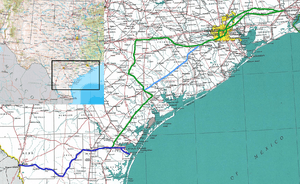Texas Mexican Railway
 | |
 | |
| Reporting mark | TM |
|---|---|
| Locale | Texas |
| Dates of operation | 1877–present |
| Successor | Kansas City Southern Railway |
| Track gauge | 4 ft 8 1⁄2 in (1,435 mm) standard gauge |
| Previous gauge |
|
| Headquarters | ? |
The Texas Mexican Railway (reporting mark TM) is a railroad that operates as a subsidiary of the Kansas City Southern Railway in Texas.[1] It is often referred to as the Tex-Mex, or TexMex Railway.
On January 1, 2005, Kansas City Southern (KCS) took control of the Texas Mexican Railway and the U.S. portion of the Texas-Mexican Railway International Bridge in Laredo, Texas. The railroad is a vital link in KCS's rail network, connecting The KCS and TFM, S.A. de C.V. While Tex-Mex remains a separate legal entity, KCS and Tex-Mex are operated as one railroad.[2]
History
19th century
Chartered in March 1875, the Corpus Christi, San Diego and Rio Grande Gauge Railroad built a 3 ft (914 mm) narrow gauge line from Corpus Christi, Texas to Rancho Banquete, Texas between 1875 and 1877, and then on to San Diego, Texas by 1879. This 52-mile (84 km) line's main purpose was to take domestic sheep from Texas ranches to the shores of the Gulf of Mexico, and received some funding from Richard King and Mifflin Kenedy. In 1881, the line was sold to a syndicate that included William J. Palmer and it was given a new charter as the Texas Mexican Railway. Under this document, the line was built an additional 110 miles (180 km) to Laredo, Texas. While the charter also allowed for other lines which would have made a 1,400-mile (2,300 km) network, including one line from San Diego to the Sabine River with branch lines to Tyler, Galveston, San Antonio, Texas, and Sabine Pass, these expansions were never constructed. The small Galveston, Brazos and Colorado Railroad was purchased in 1881 for a connection to Galveston, but a line was never built between the two railroads. In 1883 a bridge was built across the Rio Grande to Nuevo Laredo, making the Tex Mex the first Mexican-American rail connection. This granted rail access for all of Northern Mexico to the Port of Corpus Christi, devastating international commerce in Brownsville in the lower Rio Grande Valley, and its deep water port, Los Brazos de Santiago. This rail connection also devastated the commercial navigation of the Rio Grande, between Rio Grande City, Camargo, (Mexico), Brownsville, and Los Brazos de Santiago,located adjacent to the mouth of the Rio Grande. It was not until 1889 that the North American rail system connected Mexico with Canada. In 1910 an international rail bridge was completed in Brownsville, Texas and Matamoros, Tamaulipas, which is currently owned and operated by the Brownsville and Matamoros Bridge Company, a joint venture of the Union Pacific and the Mexican government.
20th century
The Mexican government controlled the Tex Mex from 1900 to 1982, when privatization made it part of Grupo TFM. The railway became 4 ft 8 1⁄2 in (1,435 mm) standard gauge on July 17, 1902. In 1906 it bought the Texas Mexican Northern Railway, and in 1930, the San Diego and Gulf Railway.
Ordered on April 22, 1938, seven Whitcomb Locomotive Works diesel locomotives were delivered between August and November of 1939. While some steam locomotives were kept until 1946 or 1947, they were almost never used, and the Tex-Mex is considered to be the first railway in the world to dieselise.[3]
They also began operating a 19-mile (31 km) government railroad from Corpus Christi to a naval air station in 1940. In 1995, the expanding KCS bought 49 percent of Tex Mex, and in 1997, the Surface Transportation Board granted trackage rights to the Tex Mex to connect to the KCS at Beaumont, Texas. Responding to increased international trade between the US and Mexico, the railroad built a large railroad yard and intermodal freight transport facility at Laredo in 1998.[4]
21st century
In 2002, however, both companies sold their shares to Grupo Transportación Ferroviaria Mexicana. In August 2004, KCS again purchased a controlling interest in Tex Mex, although they were held by a trust company until the Surface Transportation Board approved the move for January 1, 2005.[5]
References
- ↑ Kansas City Southern. "Texas Mexican Railway Facts". Archived from the original on 2006-03-12. Retrieved 2006-07-24.
- ↑ Kansas City Southern. "Texas Mexican Railway Profile". Archived from the original on 2006-04-15. Retrieved 2006-07-19.
- ↑ Ingles, J. David (2006). "Just who was the first to dieselize?". Classic Trains. Waukesha, WI: Kalmbach Publishing Company (Special Edition no. 4).
- ↑ Al Dos Santos. "Texas Mexican Railway". Archived from the original on 2006-03-26. Retrieved 2006-08-01.
- ↑ Kansas City Southern. "The Texas Mexican Railway Company History". Archived from the original on 2006-03-12. Retrieved 2006-07-20.
| Preceded by Red River Valley and Western Railroad |
Regional Railroad of the Year 1998 |
Succeeded by Providence and Worcester Railroad |